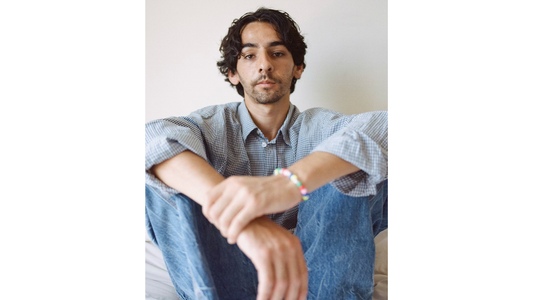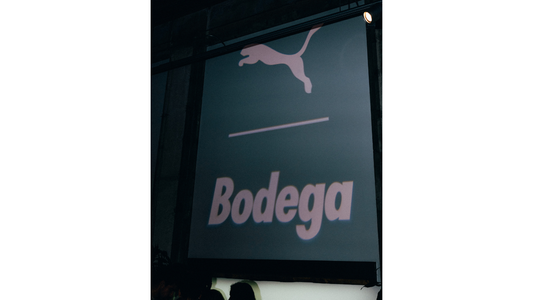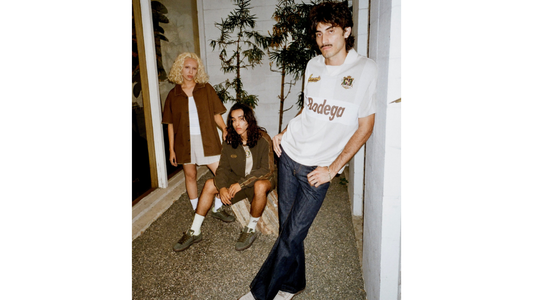Celebrating over 50 years in the art world, graffiti pioneer Lee Quiñones hasn't just done it all - he was blazing the trail while riding the rails.
Building a reputation in the underground graffiti scene of New York during the 1970s through sprawling full subway car murals, Quiñones was a key player in bringing this new and often misunderstood art form to the general public. Credited with the first above-ground graffiti mural in '78 - at his high school handball court - Lee's work would soon be featured in galleries across the world, for decades to come. But through all the fame and notoriety, his place in the Fab 5 Graffiti Crew and his role as the face of graf in the movie Wild Style, in addition to his work in the documentary Style Wars has cemented his legacy as one of the godfathers of the subculture. In honor of the release of his new retrospective book, Lee Quiñones: Fifty Years of New York Graffiti Art and Beyond, we had a chance to catch up with Lee on the early days of his career, his history of using art as a tool for communication, and why 'what is next' will always be the most critical part of his career. Check out the full interview below.
Lee in his Brooklyn studio, 2023. Photo Credit: Stanley Lumax
B: To get us started, what was your introduction to the arts back in the day?
Lee: Even before the subway movement, I was well aware of the arts - I was drawing since I was five years old, and well aware of works of art in the neighborhood, particularly sculptures and cinema theaters.
I've always loved film because my mother loved film. So instead of going to museums, I was going to sort of red carpet events with my mother. I don't know to this day how she was able to get us into those events, but I think she was part of a lottery system where they were able to have guests come and be part of the festivities at openings for major films back in the day.
B: Oh, that's amazing. Are there any red carpets or movies in particular that you remember really having an impact on you?
Lee: I remember the reintroduction to West Side Story, they had this showing of it in New York, and that was one of the most iconic, memorable ones that I went to go see. We went to see films like Dr. Zhivago and Gone with the Wind when that was rereleased… The French Connection. I mean, I was anywhere between 7, 8, 9, 10, 11 years old, 12 years old. And then I started going to films on my own.
Mural by Lee Quiñones and Fab Five Freddy in Washington, D.C., 1982, featuring a quote by Warhol. Photo Credit: Mark Gulezian
B: This adds great texture to your work. I don't think a lot of people would've connected how significant film has been to your artistic journey but it makes a lot of sense.
Lee: Yeah, I had and I still do have a keen understanding of perspective and light shadow and things like that. So there's lots of things that I attribute to my love of film. It's all about light and perspective and depth of feel. And that's bled over into my work.
As far as exposure to actual works of art, I do remember two things that were happening. Tony Rosenthal sculptures were in the neighborhood and I remember one of them at the Police Plaza, the new Police Plaza that was built in ‘72, I think it was. And I remember that sculpture being part of that facade there, and obviously he's known for the iconic spinning cube over in the West Village.
So anyway, I was exposed to that and then Richard Serra later on in the 80s. I was very much in awe of the CITYarts workshop program too, in which they were creating murals all around the Lower East Side, particularly in Chinatown near where I grew up. So that exposed me to those beautiful creations on the walls, massive, sometimes 7 stories high. And then of course, when I started seeing the subways in the early 70s, that's when I noticed the colors, the color palette there.
B: What inspired you to look at a subway car and see a canvas?
Lee: Well, at first it was an anomaly. I mean, it was basically an enigma to me because I was like, 'What is this color doing on this train?' I've always loved trains. It's a classic story. The boy with his trains. So I loved locomotives, the steam locomotives, the electrical, the diesel locomotives, and as a child, all I wanted for Christmas was a train set.
Year of the Dragon, 1979, IRT # 5 Lexington Avenue, Whole Car. Photo: Courtesy of the Artist.
B: Like a Lionel?
Lee: Lionel, HO Scale, even the really tiny Z scale trains that were really, really tiny and yet so realistically rendered and created. I loved that. And I used to be that kid at the hobby store. Remember those? I mean, there were train sets displayed on the windows, and I would just go there in awe and mirror them, being in my parents' apartment, but I didn't have the money or resources to even know how to acquire those. So I got the little Lionel's.
Obviously riding on the subways, seeing the massiveness of that system really connected the dots for me. Particularly subways in New York where they make the most noise, they're politically incorrect, and they're actually sort of in a human sense, very incorrect because they're very menacing. But they had amazing characteristics to them because these are the trains that were left over from the 1940s, still running on the rails in the 1970s. They were all very, very exciting to me. And then when I started to see the colors, I knew that there was something that was off keel, but in a good way.
‘What's going on here? What's that name? Why is that name there?’ Not even knowing about anything to do remotely with advertising, just the fact that something was painted using the alphabet and not just that, but the alphabet with style.
B: Do you remember the first time you saw your work roll by on a train car?
I remember the first time that a significant work rolled by me, which was in about 1975 and 1976. I remember it like it was yesterday. It was a celebration on wheels, Earth shaking, at least for me. But I know that it was for the people that were watching and witnessing it for the first time as well. That it was something very festive and special, that it was out of, again, a work of art massive as the train itself. You know, a 7 foot tall by 52 foot long mural was not the norm at that time. And for it to come into the station brightly painted, proud loud, with the strong scent of spray paint still wet in the air was the most amazing feeling because being anonymous, yet being out in the open like that, it was the best of both worlds. I knew that that was my production, and it was there menacingly. It was bum rushing everybody's psychic, and you don't expect art to confront you like that.
Lee Q. and Mono, Window Down Burner, 1978 TBM RR. Photo Credit: Joseph “Don1” Palattella.
B: Very powerfully.
Lee: So powerfully and very quickly becoming political. I was very aware of my surroundings and world events and society's woes and painting about them, and not wanting to just paint my name, but paint about all these influences and these current events that were ongoing, and some of them maybe being sarcastically painted to look like they were stills from a film on a subway car, but talking about the issues having to do with poverty, racism, war, society at its worst.
B: Absolutely. I wonder if that's also why - of course there were artists and even onlookers who were way ahead of their time in appreciating the work that you guys were doing - but I'm wondering if that was part of society’s critique. They didn't like seeing these issues brought up in such a confrontational way where they couldn't hide so easily.
Lee: Right, right. It was unfiltered. Just the sheer surprise of it, to come in front of you and devour you and tell you about something that you did not read in the headlines or hear from local politicians as well as the state or federal levels. You didn't hear what you were seeing in front of you. And for a young man to be painting about the conflict in Southeast Asia and saying that this is not the right thing, we're at somebody else's backyard trying to tell them how to cook the waffles that we forced onto them, that's what kept me going. I had a voice box, I had a podium to work with, and yet stayed anonymous for obvious reasons. I knew it was dangerous, what I was talking about. My name wasn't dangerous. It was the issues that I was confronting and projecting that were dangerous.
The Allen Boys, 1981, Lower East Side NYC. Photo Credit: Martha Cooper
B: To zoom out for a second, what/who were the Fab Five Graffiti crew, and how did you come to join?
Lee: Well, the Fab Five was a small group that was sort of created on the outskirts of gang culture. The guys, the initial group, the core, initial first group, small group of guys, maybe 10 guys or less, were all ex-gang members. And this one guy by the name of OG 2 decided to create a group of guys that were not going to be involved in gang activity, but had a community outlook.
So it was made up of graffiti writers that were part of gangs by virtue of their neighborhoods, the confrontations in their neighborhoods, and sometimes not having any options at all, but to be part of a gang. This group painted very early on in the early seventies: ‘70, ‘71, ‘72, even into 1973.
Here comes this young man by the name of Lee in 1974, and not on the radar yet until around 1975. There's something happening here, but no one knows what it is as the Buffalo Springfield song goes, and they, still traveling on the subways, were enamored by it. They were like, 'Wow, who's this guy? Every other day we see a brand new production, brand new whole car coming by, freshly painted', and that would excite anybody. They just wanted to find out who I was, or who we were.
They were like ‘You?! This 5 ft 4in frame of a Puerto Rican consisting mainly of rice and beans and ambition created this whole car? Yo, we want to run with you’. Mind you, these are 6 foot 3, 7 foot tall dudes, looking down on me and saying, ‘You are Lee? You are the guy we've been trying to meet?’ And that's when I met them. I knew they were a band of brothers, and I didn't know that they were even part of a gang other than their clothing, what they wore. I just thought it was a fashion statement at that time.
But they were part of a gang. They were part of different gangs at one point in time, and they were sort of retired from that wave of life, but the attitude was still there, and I felt like a protective dome over me running with those guys because I felt that I could teach them something and they could teach me not to be part of a gang. So we became the Fabulous Five, and the Fabulous Five consisted of - don't let anybody fool you - MONO 105-1, DOC109, SLAVE1, DIRTY SLUG 335, and myself. So those are the five core members who were super active on the trains at the time, until they had decided to move on with life, and I decided to continue my life in the arts and continue to make works that would survive the subways.
“Fab 5” 1979. Lee Quinones. Spray paint on canvas. Photo Credit: Farzad Owrang
B: What was your impression of what you and fellow writers had as an ultimate goal for graffiti? Was it more important to be revered by your peers or was there ever this interest in becoming known above ground?
Lee: No, I don't think it was to be popular above ground. The status quo of graffiti writers are just self-involved selfishly in some ways, sometimes in their own names and in that era and in that place, the subway’s were, to me, a chapter. It was a stepping stone. It wasn't the only thing because to me, the new movement of graffiti, if you want to call it that, was a state of mind. It wasn't a thing in a place. It was painting, and we were just using those vessels. Those vessels were used to get the work to migrate from one neighborhood to the other, and were known in that circle of people, and most graffiti writers were comfortable in that community.
But quickly, I became discomforted. There was a huge community of people, mainly people above ground that were being discounted just as we were being discounted as artists. People were pointing fingers and saying, "those kids”, when in reality it was these young people trying to change the landscape and trying to change the climate that they are succumbing to.
The climate of crime and poverty, and also the discovery of self-worth and self-agency and discovery of, ‘Wow, I'm a creative person. I have a voice’. I have a voice beyond my name, so why not use this as a vehicle in a transformative age to make this movement become a voice box for many young people?
I hate the term “kids”. I hate the term "vandals" because kids and vandals sort of go together as dysfunctional, misdirected youth, and this was far from that. These were very calculated, sharp, street smart, and very creative people that had eyes and their hands on the pulse of what was going on. You have to remember that this was a self preservation movement where the name was part of your persona. The name was part of creating a bigger sense of self, and I was beyond that very quickly because I knew I was worth something and that I could create a dialogue and a discussion with my work, and not just be about myself and my close peers, but to be inclusive of the outside society. So that's why I painted the first handball wall murals.
Howard The Duck, 1978, Whole Handball Court, Jr Highschool Corlears #56 Lower East Side NYC. Photo Credit: Martha Cooper
B: Read my mind - was just about to ask about them!
Lee: In 1978, and I can tell you safely, when I came up to the top of that wall on the ladder, the ladder just barely put me to the top of the wall, I remember standing on the very top peg of that ladder and having my arms crossed on top of that wall, 25 feet up, whatever it was and looking over my neighborhood like I had a bird's eye view, an angel's view of the neighborhood. That's what it felt like.
I remember saying to myself, ‘My God, I have arrived as an artist. This is my arrival moment. This is my breakthrough moment’. But this is also the breakthrough moment for this movement.
And to this day, I still read and hear in interviews where people said they would do these cross town excursions to those walls because they couldn't believe they existed. No one could believe it. Writers, graffiti writers from the ever reaches of Riverdale, N.Y or East New York and the Rockaways and the outskirts of Bayside Queens would take buses and trains to come to the Lower East Side to see this, because they couldn't believe it. They couldn't fathom it. They couldn't believe the size, the magnitude, the composition, the style behind it, the exercise of light - going back to cinema - depth of feel, shadow, and the color palette...they were just awestruck. And that's where I sealed the deal.
B: Legendary. So to backpedal for a second, when you bring up self-worth and the value of that in creative endeavors, what do you think gave you that sense of self-worth?
Lee: I think it's insidiously in anyone that's been pushed down. It's inherently in your DNA. It's just you have to find the outlet, and sometimes the outlet is against the grain. Sometimes you gotta make that hole in the fence…you got to make a hole in the fence to get to your destination, to add that supercharged moment to your trajectory, to your journey.
I just sculpt it painting by painting. I sculpted right in front of my eyes because I was using those vehicles at that time as a safe house for my ID. I came up with a saying one time based on a saying, ‘everyone loses their ID every now and then’. I don't mean, oh, “I don't have my ID with me. I lost it”. It’s that we lose our ID because of the way we're pushed and the way we're spoon fed and force fed stuff to feel degraded and discounted and irrelevant.
I knew that what I was creating was beautiful, powerful, unified, and certified for the times and the era. The city had fallen apart. It was in a fiscal crisis, never before seen, and no one saw a way out. The youth did.
Lee drawing in his childhood bedroom at the Alfred E. Smith houses circa 1981-1982. Photo: Courtesy of the Artist.
"This art form is not a sport. It is a way of life. It is a state of mind. That's what art is about."
B: That's part of what I loved about Wild Style so much. You and the people involved in that film were kind of dispelling the narratives around street art and the youth movements in New York City and showing it for more of what it was, and something that I took away from it was definitely this idea of hope.
Lee: Yes, yes. And then the identity too, when you think about it conceptually, to use a vehicle that carries thousands, millions of people to their destinations - the most boring places on earth, the places they hate: their jobs, or maybe even their homes, unfortunately, right? I mean, some people went to broken homes, some went to deadbeat jobs, and they use these things, the trains, as the most economical ways of getting around the city. It's the blood of the city.
But yet these things became these tablets of someone's voice, voicing their opinions, their frustrations, their fears, their relations, celebrating oneself in the darkness. Amazing, an amazing concept. And for it to grow and mature into a major global art movement. Now that has influenced major household names indirectly or directly is another miracle. I mean, we have break dancing in the Olympics.
B: I know, pretty historic.
Lee: This art form is not a sport. It is a way of life. It is a state of mind. That's what art is about. So I don't expect it to be in the Olympics. Though, it comes from a very competitive natured background. So I'd go and outstage everyone. I got past that upstaging phase very quickly though because who I really wanted to tantalize was the riding public. Thus, that was my road to the art world because the public, outside of our small, yet powerful conversation was very dear to me. I wanted to have conversations with people I would never, ever get to meet.
It was a very democratic movement, and I think that that was the beauty of it, and I think that's the beauty of art, is that art can come from unexpected places by unexpected faces.
Utica, 2020, Spray Paint, Pastel Pencil on Clayboard, 44"w x 18"h
B: After building up so much experience expressing your art on, for example, walls, concrete, trains, what was it like transitioning to canvas, for example, and then with that, having your work begin to be shown in gallery settings?
Lee: Well, it was a very slow transition for me because it was very - I was still well tethered to the life and the lifestyle in the world of trains that helped me survive the atrocities that happened in my neighborhood, to my people. And yet, the people that embraced me in the art world were people that were either there by privilege or by coincidence and curiosity, hovering around the art world.
And it took me a while to understand that and respect that people that were outside of my community actually were there to help me in some way. They didn't necessarily walk me through and explain it. I wasn't aware of a playbook. There was no playbook. Everything was so new and uncharted. I had to figure it all out on my own, sometimes by fault of falling down and getting back up because the art world was not very embracing for a long time of artists that were outside of the…very elitist society.
There was always a lot of money, a lot of commerce, a lot of conversations, intellectual conversations in the art world that only included certain people because they wanted to protect their self-sustainable world, not realizing that there were great works of art always being made by other people that were excluded outside, whether that was because of race, color, whatever, cultural differences. The Harlem Renaissance is a perfect example. Even the Dada-ists are a perfect example. Agitators, no different from the graffitists, the subway graffitists that were agitators in their own way - for maybe very good reasons.
There's always a food fight at the table, but there's always a way to bring the cream to the top. I think the art world had to go through a self-questioning, a self-evaluation to understand that there are very relevant, very credible creators, artists, voices that are now existing that have always been existing, and they have something to put into the melting pot.
Lee and his “Debbie Harry” portrait at the PS1 “New York-New Wave” show 1981. Photo Credit: Martha Cooper.
B: I really liked your point earlier about how the art you were making wasn't an accident. It was very calculated, very thoughtful, very intentional. Just like any other highly regarded art at the time. At some point, people who might have looked down at that type of art, were forced to realize, ‘Wait a second, this is actually the next crop of legitimate artists’. They just happened to be doing things differently and paving their own path.
Lee: Right. Way beyond the flash moment, the Super Bowl touchdown moment of that era of the subways, we are now seeing artists that have never even seen those subways because they weren't even born yet, very much influenced by it.
Every art movement has gone through a process of, not elimination, but a process of culmination. We're at that moment where we're all meeting 30, 40, 50 years after the fact and enabling us all to see the flames of that spark. And because of that, we can actually reflect back and actually connect the dots of a great art movement and the great's within that art movement.
This particular movement, a phenomenal movement, has influenced the entire planet. I've never seen anything like it. And it's because it's a movement by young people, for young people of all ages. If you're willing to be open-minded and not close-minded, you are always going to be young.
Chapter 11, 2002, Acrylic, Spray Paint, Charcoal, and Oil on Canvas, 168"w x 108"h
B: You just came out with a book right? Can we talk about that for a bit?
The book was my way of hitting everybody over the head, including some of my contemporaries, because I could sit here and tell you many hundreds of glory and gory stories and keep everyone entertained about all these grand happenings, circumstances, all kinds of stuff. But I wanted to start the conversation with this book. It's subtitled, “50 Years of New York Graffiti and Beyond” for a reason. “Beyond” is the word.
I'm not going to trade baseball cards with you for the rest of my life. I'm going to move the needle forward and upward. This book showcases and harnesses the evolution of the work and my perseverance.
And sometimes I have nothing to say. Sometimes I have absolutely nothing to say. So I'm silent, radio silence across the waves right? But that doesn't mean I'm not tinkering and rethinking and not critically thinking things over. The wheels are always turning,
B: It makes the statements you do say more powerful when you do decide to weigh in.
Lee: Yes! You marinate with things. You calculate things. You rehearse things. And when you're ready to bum rush the status quo of society, then you're ready. And that's when art arrives best -when it is ready. It was ready in 1969. It was ready in 1975. It was ready in 1978, and it's ready in 2024. For me, it arrives when it needs to be at its arrival gate, at its perfect time.
Installation view of If These Walls Could Talk, 2019, spray paint, acrylic, paint marker, ink, and pencil on gypsum.
Photo Courtesy of Charlie James Gallery, Los Angeles.
B: Well, I don't think there could be a better endorsement of your book than that.
L: Trust me…I could talk about nostalgia all day long, but I don't want to be labeled and contextualized by that only. I want people to say, 'Wow I want to see his next show'.
B: I mean, it must be so easy if you wanted to just rest on your laurels, but it's so hopeful and refreshing to hear from a decorated artist that's like, ‘Yeah, I did this stuff in the past, but I'm not done. I'm still an artist. I'm still putting out stuff. I'm still making art’.
Lee: Right? Absolutely. I mean, the artist is a nomad. He or she takes leaps of faith, failure or success into different avenues and uncharted waters. I came from a very loving family in a very, very challenging atmosphere. And I'm very proud of where I came from. I wouldn't change it for the world, but I know that I can make changes in my life and hopefully elsewhere too.
I can not be threatened by people, by their sexuality or their political stances or their cultures. I don't have to be threatened by that, but I could have been if I would've stayed on the block. Some people never left the block. I left the block to paint. And in that way, I crossed those bridges literally and spiritually. I crossed those bridges to enable me to think outside of the box and approach an art form in an unorthodox way.
Photo Credit: Aviva Klein
B: Lee, this has been an amazing conversation. We’re just so honored that you took the time to talk with us. I guess to close out, in the spirit of looking forward, what’s next?
Lee: Well, I'm doing a number of series’ - I'm doing a series all titled in Spanish. I was born in Puerto Rico and came here at 8 months old to the Lower East Side. So I'm kind of a certified Nuyorican. I'm painting about my family's past, growing up in the projects, not just growing up in the projects, but growing up in the atmosphere of the loving home of my parents - a very challenging home too. We had our flying skillets and flying sandals going around corners. My mother “MOM 101”could throw a sandal and it'll go around the corner, hit you upside your head and reverse right back to her like a boomerang. LOL.
Send in the Clowns, 2009, Acrylic, Spray Paint, Pastel Pencil, Charcoal, and Printed Matter on Canvas, 60"h x 50"w
Red Dawn, 2021. Acrylic, spray paint, pastel lead pencil on Canvas, 68"h x 59"w
B: Boomerang sandal.
Lee: There were those dysfunctional moments, those scattered and disenfranchised moments, despair. And then there were moments of dare. I dare myself to do this. And I'm painting about that. So every painting will be titled in Spanish in a very sarcastic and humorous way. All the titles that sound really funny in Spanish actually sound different in English. And I love the juxtaposition of those two worlds and how they can sound different and feel different from one side of the fence to the other. And it's called "El Apartamento".
The next series is about the really strange water and oil mixture of high technology and humanity. And those are going to be difficult to create across the playing fields of conversation because that social sandbox may be not so friendly. But I want to talk about that. I just want to talk about that.
And with the third, I'm very excited about going back to cinema. Sara Driver is an amazing producer and director, and the life long partner of Jim Jarmusch. She's making a deep sea dive, an in-depth documentary on my life's work. She’s looking to create a really beautiful piece based on my humble beginnings and my contribution to this movement. But also my influences through music, my family, my community, my struggles, and the fact that when people said, ‘You can't do it’. I said, ‘Watch me’.
B: Hell yeah. Yeah. Well, I mean, those 3 projects all sound very exciting and we look forward to seeing them roll out.
Lee: Not to mention volume 2 and volume 3 of my book, to give everybody a different temperature in the room. Enable everybody to connect the dots. That's what I want to do.
Lee Quinones, Coney Art Walls, New York City 2017. Photo Credit: Martha Cooper.







